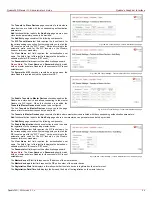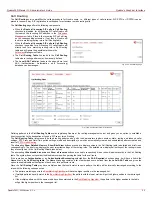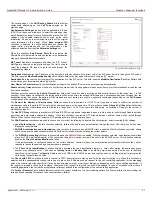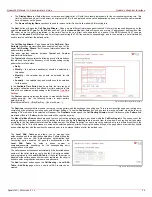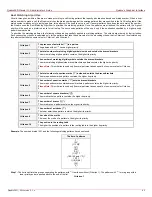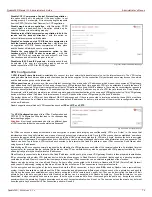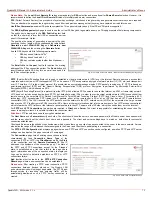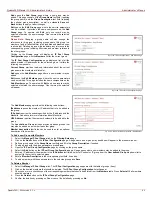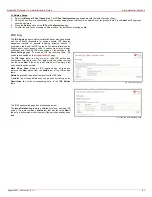
QuadroFXO Manual II: Administrator's Guide
Quadro's Graphical Interface
QuadroFXO; SW Version 5.1.x
66
RADIUS Client Settings
RADIUS (Remote Authentication Dial In User Service) specifies the RADIUS protocol used for authentication, authorization and accounting, to
differentiate, to secure and to account for the users. The RADIUS Server provides the option for a caller from/through Quadro to pass authentication
and to be able to dial a specific number.
When a RADIUS client is enabled on the Quadro, and according to the configuration of AAA Required option (see
table), the RADIUS
server will be used to authenticate user and/or to account for the call. This can be accomplished by automatic detection of the caller’s number or a
customized login prompt where the caller is expected to enter a username and password.
Transactions between the client and the RADIUS server are authenticated through the use of a shared Secret Key, which is never sent over the
network. In addition, user passwords are encrypted when sent between the client and RADIUS server to eliminate the possibility of a party viewing
an unsecured network where they could determine a user's password. If no response from the RADIUS Server is returned after the Receive Timeout
expires, the request is resent numerous times as defined in the Retry Count list. The client can also forward requests to an alternate server(s) if the
primary server is down or unreachable. An alternate server can be used after a number of failed tries to the primary server.
Once the RADIUS server receives the request, it determines if the sending client is valid. A request from a client that the RADIUS server does not
recognize must be silently discarded. If the client is valid, the RADIUS server consults a database of users to find the user whose name matches the
request. The user entry in the database contains a list of requirements (username, password, etc.) that must be met to give access to the user. If all
conditions are met, the user gets access to the Quadro Network.
The RADIUS Client Settings page contains the Enable RADIUS Client checkbox that enables RADIUS client on the Quadro.
Please Note:
The RADIUS Client cannot be disabled if there is at least one route with RADIUS Authentication and Authorization or RADIUS
Accounting values configured in the AAA Required drop down list at the
table. In order to be able to disable the RADIUS Client on the
Quadro, appropriate routes should be removed first.
The other RADIUS Client settings are divided into three groups:
1. Registration Settings
The Primary Server requires the IP address of the primary Radius
Server.
The Secondary Server requires the IP address of the secondary
Radius Server.
NAT Station IP text fields require the NAT PC WAN IP address. If
no NAT Station is specified here, Quadro’s IP address will be sent
to the RADIUS server.
Secret Key is used to insert the secret key between the Radius
client and the server. Contact the Radius server administrator to
get the secret key for your Quadro.
The Confirm Secret Key field is used to verify the secret key. If
the entered Secret Key does not correspond to the one in the
Confirm Secret Key field, the error message “The Secret Key
does not match. Please try again” will appear.
Retry Count allows you to select the number of attempts
authorized before canceling the registration.
Receive Timeout allows you to select the timeout (in seconds)
between two attempts to register.
Encoding Type allows you to select the encoding type (PAP or
CHAP) that should be unique on both the client and the server
sides for the establishment of a successful connection. Encoding
type should also be requested from the Radius Server
administrator.
The Authorization Port text field requires the port number on the
RADIUS server where Quadro is to send the authentication
requests.
The Accounting Port text field requires the port number on the
RADIUS server where Quadro is to send the accounting
messages.
Fig. II-112: Radius Client Settings page
2. Authentication Settings
The Enable common login for all users in time of by Phone authentication checkbox enables custom settings for the callers who passed an
authorization by phone on the Quadro. This checkbox enables Username and Password text fields to insert the custom settings that will stand
instead of the source caller’s settings when being delivered to the RADIUS server.
The Authentication on Destination RADIUS Server parameters group is used to insert a Username and a Password (followed by the password
confirmation) to pass authentication on the RADIUS Server of the destination Quadro. If these fields are left empty, the original authentication
settings that users enter for authentication will be used.



